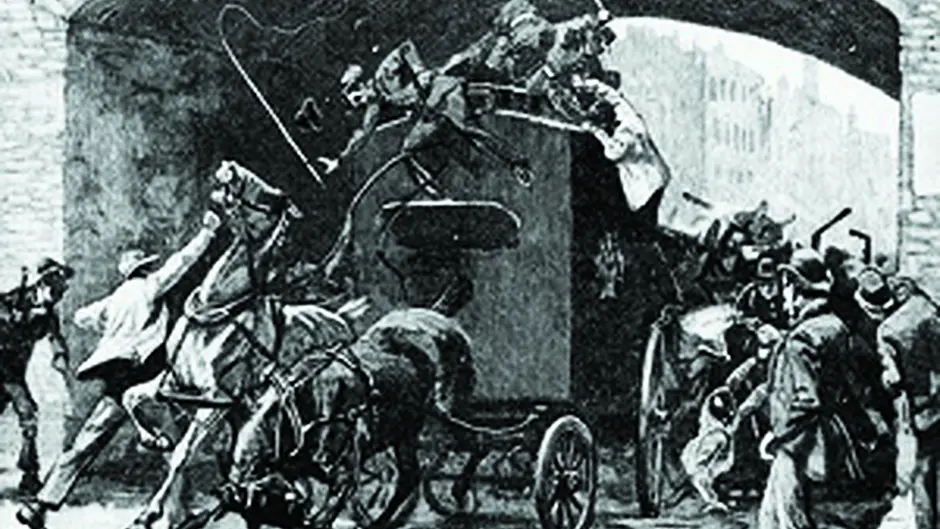Robert Hume reflects on the ambush of a police van in Manchester on September 18th 1867 and the subsequent trial which had resonances much further afield, including here in West Cork
Robert Hume reflects on the ambush of a police van in Manchester on September 18th 1867 and the subsequent trial which had resonances much further afield, including here in West Cork
MANCHESTER 18th September 1867.
A horse-drawn police van, led by 12 mounted policemen, is heading towards Belle Vue Gaol.
Handcuffed and locked in separate compartments inside, are two senior Fenians, charged with vagrancy. Colonel Thomas J Kelly from Galway; and Clonakilty-born Captain Timothy Deasy.
The van also held three women convicted of drunkenness, and a 12 year-old boy being taken to a reformatory.
As it passes under the railway bridge by Hyde Road, a man suddenly darts out in front of them, points a pistol at the driver, and tells him to stop. Meanwhile, a group of 30 or 40 men leap over the wall of an adjoining brickyard and seize the horses, shooting one.
While police flee from the scene, the men begin attacking the van, jumping on the roof and beating it with stones. They call on Police Sergeant Charles Brett to open the door, but he refuses. One man puts his revolver to the keyhole to blow the lock. At that exact moment Brett has his eye there to see outside. A shot rings out. The policeman is killed instantly.
One of the prisoners, Emma Holliday, takes the keys from Brett’s pocket, and passes them through a ventilation grill to the group outside.
Kelly and Deasy manage to escape, with help from fellow Fenian, James Cahill.
Despite an extensive search, and a £300 reward for their capture, neither is seen again.
The plan – the latest in a series of Fenian ‘outrages’ aiming to bring an end to British rule in Ireland – was devised by Richard O’Sullivan Burke from Dunmanway.
Public opinion seeks revenge for the shooting, so the police raid a series of Manchester addresses, seemingly arresting suspects at random.
Twenty-six men, said to have been present that day, are brought before the Manchester courts in handcuffs, to face a five-day trial ‘in a climate of anti-Irish hysteria’. Their guilt is assumed.
On 28th October, five are convicted of murdering Sergeant Brett. William Philip Allen, a 19 year-old carpenter, living in Manchester, had been brought up in Bandon where his father was the bridewell keeper.
Michael Larkin, a tailor and father of four from Banagher, Co Offaly, was fund-raising for the Fenians in Manchester.
Michael O’Brien, a draper’s assistant from Cork city, had participated in the unsuccessful Fenian uprising in Dublin in March.
Edward O’Meagher Condon, an American citizen, originally from Mitchelstown, had helped direct operations on the day Brett was shot.
A fifth man, Thomas Maguire, an Irish royal marine, home on leave, was simply ‘seen nearby’.
Allen claims he had to wear a handkerchief on his head while in custody, so witnesses could identify him easily. He professes his innocence but is prepared to die to defend the liberty of ‘an oppressed and enslaved people’.
O’Brien maintains that all the evidence against him is false: he did not have a stone in his pocket, let alone a pistol.
On November 1st, all five are sentenced to death by hanging.
However, Maguire is reprieved because the evidence against him is considered unreliable. Condon’s sentence is overturned when the US ambassador intervenes on the eve of his execution.
The other three are less fortunate. On 23rd November, Allen, Larkin and O’Brien are hanged from the gallows in Salford Gaol, watched by a mob of 10,000 people, singing, and full of bloodlust.
Allen dies instantly, but bungling hangman William Calcraft miscalculates the length of rope required for Larkin, and has to go below to pull on his legs.
Prison chaplain Father Gadd steps in to spare O’Brien the same fate. Instead of reveiving a Christian burial, their bodies are covered with quicklime.
By the end of the year, a ballad about the incident, called God Save Ireland, was being sung across the country, highlighting the injustice. Although present that day, there is no evidence that any of the three shot Charles Brett. Historian Joseph O’Neill concludes that they were “victims of violence as much as its purveyors”.
On September 7th 1890 the San Francisco Call published an astonishing revelation. From his hospital bed, rescuer James Cahill had broken his sllence to say that it was a man called Peter Rice who had put his revolver to the keyhole and shot Sergeant Brett that day.
To mark the 150th anniversary of their execution, the Reference & Local Studies Department of Cork County Library has mounted a mini exhibition at its headquarters on Carrigrohane Road, Cork. It includes a display of books about the affair and the Fenian movement generally. The exhibition runs until the end of the year.
See www.corklocalstudies.ie.







